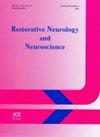抗瘤素A10和AS2-1治疗4例持续性、复发性和进行性神经节胶质瘤儿童的II期研究结果
IF 1.6
4区 医学
Q4 NEUROSCIENCES
引用次数: 1
摘要
理由:神经节胶质瘤一般为良性肿瘤,被世界卫生组织(WHO)列为I级或II级肿瘤。然而,在1-5%的病例中,神经节胶质瘤的表现更具侵略性(WHO分级III),预后更差。本文详细介绍了4例神经节胶质瘤患儿,并讨论了抗瘤质体A10 (Atengenal)和AS2-1 (Astugenal)治疗神经节胶质瘤的疗效。目的:根据II期方案BT-10和BT-11,在博金斯基诊所(BC)接受抗瘤素A10和AS2-1 (ANP疗法)治疗。ANP治疗通过锁骨下导管和输液泵输送。在ANP治疗期间,通过脑序列磁共振成像(MRI)与基线脑MRI的比较来确定肿瘤反应。结果:四名接受神经节胶质瘤治疗的儿童中,所有人都接受过手术治疗,但没有人接受过放疗或化疗。2例肿瘤复发和进展,可能发生高级别转化(丘脑-中脑区;2例脑干肿瘤(持续性多中心神经节神经胶质瘤;神经节神经胶质瘤(神经节神经胶质瘤,发生于下髓及颈上脊髓),较难治疗,预后较差。体格检查结果与每个孩子的肿瘤位置相符。静脉ANP治疗持续6.4 ~ 24.8个月。两名可能发生高级别转化的儿童获得了部分缓解(PR),而两名患有脑干肿瘤的儿童保持了稳定的疾病(SD)。这4名儿童的总生存期从10.3年到22.4年不等。结论:介绍了ANP治疗小儿神经节胶质瘤的应用情况。我们的结论是,ANP治疗是神经节胶质瘤儿童的一个有吸引力的治疗选择,这些儿童不适合或拒绝手术切除和/或表现出持续、复发或进展的疾病,在手术切除后伴有或不伴有高级别转化。本文章由计算机程序翻译,如有差异,请以英文原文为准。
Outcomes in Four Children with Persistent, Recurrent, and Progressive Gangliogliomas Treated in Phase II Studies with Antineoplastons A10 and AS2-1
Rationale: Gangliogliomas are generally benign tumors and are classified by the World Health Organization (WHO) as grade I or II tumors. However, in 1-5% of cases, gangliogliomas can behave more aggressively (WHO grade III) and have a worse prognosis. Four children with a ganglioglioma are presented to detail and discuss the efficacy of Antineoplastons A10 (Atengenal) and AS2-1 (Astugenal) in the treatment of gangliogliomas. Objectives: The children were treated with Antineoplastons A10 and AS2-1 (ANP therapy) at the Burzynski Clinic (BC) according to the phase II Protocols, BT-10 and BT-11. ANP therapy was delivered via subclavian catheter and infusion pump. During ANP therapy, tumor response was determined by comparison of sequential magnetic resonance imaging (MRI) of the brain with a baseline brain MRI. Findings: Of the four children treated for gangliogliomas, all had prior surgery but none had radiation therapy (RT) or chemotherapy. Two had recurrent, and progressive tumors with possible high-grade transformation (thalamo-mesencephalic region; temporal lobe with leptomeningeal spread) while two had tumors of the brain stem (persistent multicentric ganglioglioma; persistent and progressive ganglioglioma of the inferior medulla and superior cervical spinal cord), which are more difficult to treat and have a worse prognosis. Physical findings corresponded with the location of each child’s tumor. IV ANP therapy continued for 6.4 to 24.8 months. The two children with possible high-grade transformation achieved a partial response (PR) while the two children with brain stem tumors maintained stable disease (SD). Overall survival for these four children ranged from 10.3 to 22.4 years. Conclusions: The utilization of ANP therapy in children with gangliogliomas is presented. We conclude that ANP therapy is an attractive therapeutic option for children with gangliogliomas who are ineligible for or refuse surgical resection and/or demonstrate persistent, recurrent, or progressive disease with or without high-grade transformation following surgical resection..
求助全文
通过发布文献求助,成功后即可免费获取论文全文。
去求助
来源期刊
CiteScore
5.40
自引率
3.60%
发文量
22
审稿时长
>12 weeks
期刊介绍:
This interdisciplinary journal publishes papers relating to the plasticity and response of the nervous system to accidental or experimental injuries and their interventions, transplantation, neurodegenerative disorders and experimental strategies to improve regeneration or functional recovery and rehabilitation. Experimental and clinical research papers adopting fresh conceptual approaches are encouraged. The overriding criteria for publication are novelty, significant experimental or clinical relevance and interest to a multidisciplinary audience. Experiments on un-anesthetized animals should conform with the standards for the use of laboratory animals as established by the Institute of Laboratory Animal Resources, US National Academy of Sciences. Experiments in which paralytic agents are used must be justified. Patient identity should be concealed. All manuscripts are sent out for blind peer review to editorial board members or outside reviewers. Restorative Neurology and Neuroscience is a member of Neuroscience Peer Review Consortium.

 求助内容:
求助内容: 应助结果提醒方式:
应助结果提醒方式:


